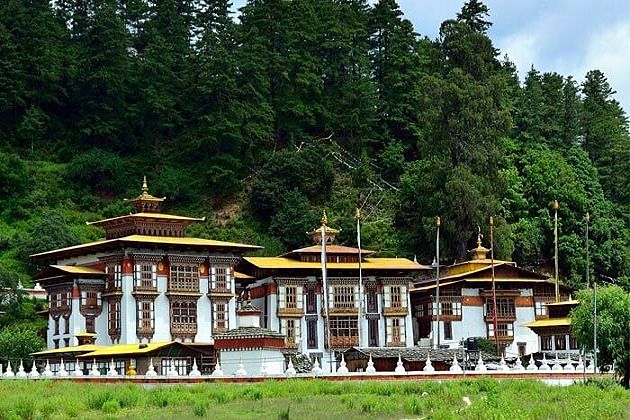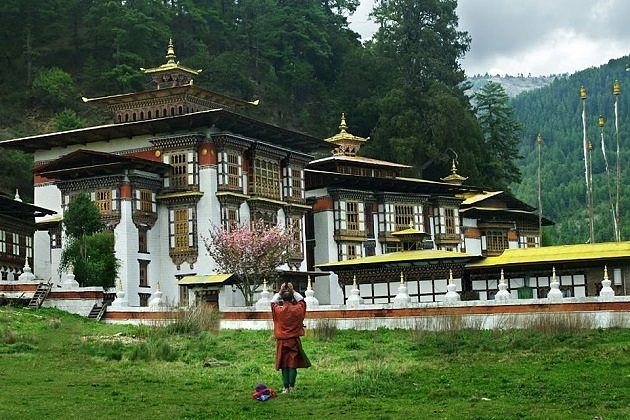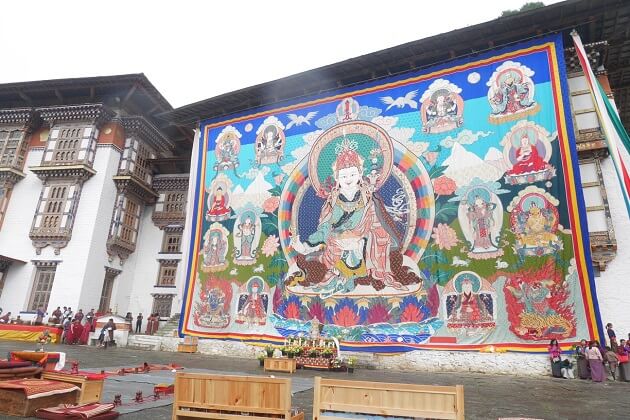History of Kurje Lhakhang
It is said that, in the 8th century, Bumthang district was under the reign of a king named Sendha (also known as alias Sindhu Raja) who feuding with Naochhe (means Big Nose), an Indian killing the Sindhu Raja’s son and his 16 attendants. In his angry, the Raja King desecrated the Bumthang deity (Shelging Kharpo) who then revenged the King as he turned the skies into black and stole the King’s life force letting him to the edge of the death.
Due to that urgent circumstance, the secretaries of the King invited the tantric Master Padmasambhava (saint Guru Rinpoche) to his superpower to save the king Sindhu Raja’s life. The saint Guru Rinpoche meditated and left his kur (body) & je (imprint) on a rock, now surrounded by Kurjey Goemba. The fact that the saint Guru Rinpoche married the king’s daughter – Tashi Khuedon. Once he asked her to go and fetch some water in a golden ewer. While she was away, he turned into his Eight Manifestations and started to dance in the meadow. Amazingly, all the local deities came and witnessed it – except Shelging Karpo. As the king’s daughter was back, he turned her into 5 princesses and each of them held a golden ewer. That was what Guru Rinpoche waited so long and he changed himself into a holy griffon. He swooped down and subjugated Shelging Karpo making him give back the vital principle of the king. Also, Guru Rinpoche forced Shelging Karpo making a promise not to cause any trouble for Buddhism and to become a deity of protector. The saint Guru Rinpoche then planted his staff in the ground where it grew up into a cypress tree. About Shelging Karpo, he has been still the deity of Kurjey.
The Architecture of Kurjey Lhakhang
Kurjey Lhakhang (one of the well-known Bumthang Attractions) consists of three buildings facing south. The first building on the right (faces to the East) is the oldest one constructed on the rock where saint Guru Rinpoche meditated by King Sendha after his conversion to Buddhism in Bumthang. In 1652, the first building was rebuilt by Minjur Tenpa while he was Trongsa Penlop – before becoming the third Desi of Bhutan.
The second building named the Sampa Lhundrup temple was structured in 1900 by The first King of Bhutan – Ugyen Wangchuck. This building is home to a monumental statue of saint Guru Rinpoche followed right after the advice of the great Nyingmapa Lama, Rigzin Khamsum Yondrol, the Bakha Trulku.
The third building of Kurjey Lhakhang, also known as the Ka Gon Phur sum Lhakhang consecrated in June 1990 by the master Dilgo Khyentse Rinpoche. This new Lhakhang was undertaken by the Queen Mother - Mayumi Choying Wangmo Dorji in 1984 under the advice of Dilgo Khyentse Rinpoche.
In front of the three temples, there is a courtyard paved with stones and built a wall with up to 108 chortens around the whole complex – Kurjey Lhakhang. A large wheel of life which depicts a variation of heels and heavens placed on the porch in front of the temple. At the bottom of Kurjey Lhakhang stand a man being judged with black and white stones which represent his good and bad deeds. Once there, you can see a mystic spiral mandala on the opposite wall. Also, there are several interior murals showing varied monastic rules and regulations consisting of the strict dress code.
The Kurjey Tshechu
Kurjey tsechu popularly celebrated in June includes a masked dance that illustrates the defeat of Shelging Kharpo. The Guru Tshengye Thondrol – a large thangka presenting the Guru Rinpoche’s eight manifestations, is revealed in the early morning before the performance of dances.
The Best Time to Visit Kurjey Lhakhang
Generally, you can visit Kurjey Lhakhang all year round. So, don't worry too much, just enjoy your Bhutan tour packages. In the morning, during the prayer hours is supposed to be the best time to visit the temple.




